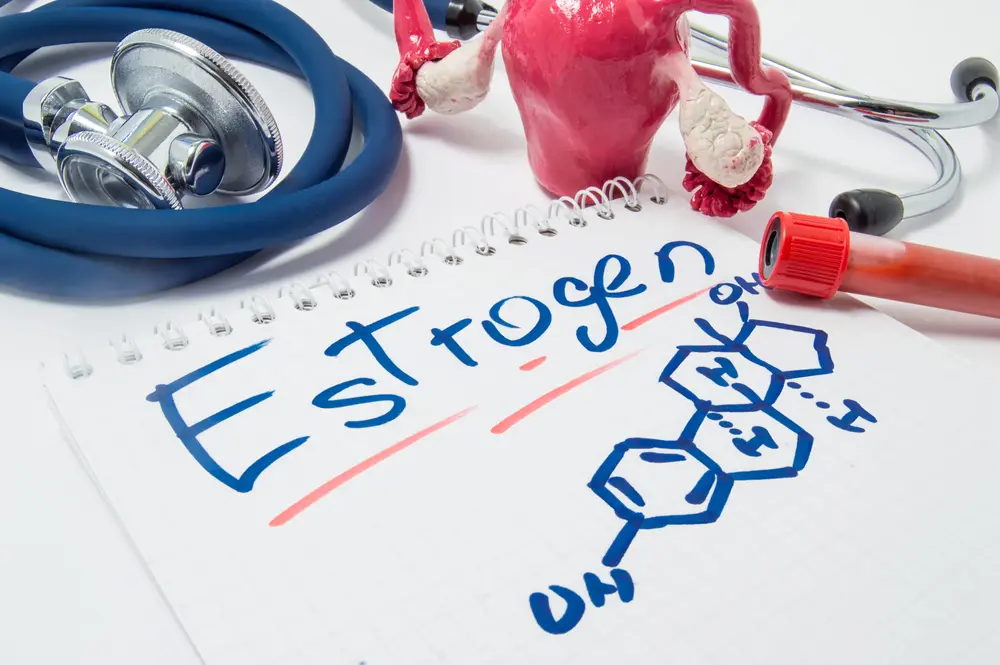In earlier blogs, I’ve talked about what I learned as a compounding pharmacist about testosterone and progesterone… now it’s time to discuss the estrogens!
When I turned 40, I bought a book about menopause so I’d know what was coming… and I chose Miriam Stoppard’s, Menopause. Her descriptions of the extensive the actions of these hormones were throughout the body amazed me and began my fascination with the world of hormones. My learning eventually spread to attending conferences in Houston and Toronto as well as online, searching for studies and learning from (and for!) my clients. Here is some of what I learned… While much will be familiar, depending on your depth of previous study, I hope to introduce some ideas and research you haven’t been introduced to before.
Actions of the estrogens
Estrogens act on many tissues and functions in the body, from our skin, blood clotting, electrolyte balance, cholesterol mobilization, bone and brain, to the uterus, vagina, breast, ovaries, and likely other sites not yet identified. While estrogens are known for their ability to stimulate tissues that are involved in reproduction, particularly breast tissue and the endometrial lining of the uterus, they also generally stimulate growth of cells in many other areas of the body that also contain estrogen receptors. These are referred to as “estrogen-responsive” tissues. Overall, estrogens are hormones that encourage growth and activity of receptive body cells. This is likely familiar information to most of you.
We produce many estrogens
Estradiol, estrone and estriol are the 3 main estrogens in a woman’s body, but humans produce over a dozen estrogens. Some are strong and others are weak, and the balance between these is important. Stronger estrogens give us the hormone actions we need, while weaker ones appear to play a protective role as well as providing some action. Like all steroid hormones, they are produced by sequential conversion from the cholesterol molecule through several pathways.
The immediate precursors in the metabolic sequences producing estrogens are testosterone, progesterone/hydroxyprogesterone and dehydroepiandrosterone (DHEA)/androstenedione. And progesterone is an earlier precursor molecule common to all steroid hormones. Some women choose to supplement with a precursor molecule, allowing the body to create the hormone metabolites it needs. I have had a surprising number of clients who have achieved relief of their menopause symptoms with only transdermal progesterone, many of whom had a history of persistent xenoestrogen exposure. Xenoestrogens (or “foreign” estrogens) are environmental chemicals that mimic or disrupt estrogen in the body, and some of these persist in the body for many years after exposure. Examples are DDT, PCBs, BPA, phthalates and the now-banned DES (diethylstilbestrol) that caused birth defects. As progesterone opposes estrogen action, it likely opposes some of the hormonal effects of these chemicals as well, although this remains to be proven.
Estrogen receptors
Different areas of the estrogen molecule connect to various receptors. These receptors, as identified thus far, have been classified as Estrogen Receptor alpha (ERa), Estrogen Receptor beta (ERb) and G protein-coupled estrogen receptor 1 (GPER1). These receptors that connect with different parts of the molecules provide an explanation for why small changes in one section of the molecule can preserve some hormone actions while changing others. We see this difference in the actions of estradiol and estriol.
Estradiol
Estradiol is our most potent estrogen. It’s the main estrogen before menopause, and this is likely why it’s the estrogen most often used in hormone therapies for menopause symptoms. In addition to its effects in the brain, improving mood and memory, and calming vasomotor symptoms, it also stimulates growth of breast, vaginal and uterine endometrial cells.
Estriol
Estriol, on the other hand, works well to improve vaginal atrophy, improves vasomotor symptoms somewhat, and reduces risk of urinary tract infections, but does not increase growth of breast and endometrial cells at moderate doses. It is considered neutral (or possibly slightly positive) in protecting bone and, overall, is much weaker in action than estradiol.
Estriol is the weakest of the 3 main estrogens and is the dominant estrogen during pregnancy. It has been thought of as a safer estrogen, as pregnancy is associated with lower breast cancer risk, as well as because it is a weaker estrogen that is a metabolic end-product and cannot be changed back into stronger estrogens. However, like all estrogens, safety is likely dose dependent and the lowest effective dose should always be used. It is also the most abundant estrogen in the urine of all women… it’s a weaker end-product estrogen that is eliminated unchanged. We often compounded estriol into a gel that was effective for vaginal atrophy while having little effect on other estrogen receptors at a dose of 0.5 to 1 mg inserted nightly initially, reduced to as needed when improved. I often recommended this therapy for women with objections to using hormone supplements who did not respond to vaginal lubricants or adhesive gels (Replens).
Estrone
Estrone is the dominant estrogen after the menopause change. It is mainly produced in adipose tissue from testosterone and androstenedione (facilitated by the aromatase enzyme), and by reversible conversion from estradiol. Estrone can also be stored in the form of estrone sulphate. Although much weaker than estradiol, it is thought of as a less favorable estrogen, likely due to its ability to be stored in fatty tissue and returned to the circulation later as estrone or converted back to the stronger estradiol.
Incidentally, Estriol, Estradiol and Estrone are named for their -OH (hydroxyl) groups – Estriol (E3) has 3 of these, Estradiol (E2) has 2, and Estrone (E1) has only one.
Balancing the growth effect of estrogen
Progesterone is known to oppose the growth stimulation of estrogen in the uterus, and progesterone and its synthetic analogs are included in hormone therapies to prevent endometrial hyperplasia in women with a uterus. However, the weak estrogen, estriol, also appears to have a balancing function for the stronger estradiol. We see this principle used in the newer menopause hormone therapy combination product: conjugated estrogen with bazedoxifene.
Bazedoxifene is a selective estrogen receptor modulator (SERM), with properties similar to our own estrogen, estriol. It works in this combination product to prevent estrogen-induced endometrial hyperplasia, negating the need for a progestin. The product is recommended as an alternative for women with breast tenderness or intolerable side effects from progestin therapy. This suggests that this SERM has a blocking effect on estrogen action in the breast as well as the uterus, similar to our own progesterone and raloxifene, but different than the synthetic progestin, medroxyprogesterone (known to cause breast soreness and suspected of increasing breast cancer risk) and tamoxifen (used to reduce breast cancer risk, but known to increase risk of endometrial cancer). So, SERMs are a heterogeneous group that can have active or blocking effects on different estrogen receptors, depending on their structure.
Estrogen metabolism
Most estrogen metabolism occurs in the liver via the cytochrome P-450 enzyme system. There are three main pathways for metabolism of estrogen leading to elimination: the 2-hydroxyestrone, the 4-hydroxyestrone and the 16-alpha-hydroxyestrone pathways, which produce catechol estrogens through methylation, a common process the body uses to eliminate toxins and drugs.
The rate at which estrogens are metabolized and eliminated varies in different individuals, depending on how efficient their CYP-450 enzyme systems are and what other drugs, chemicals or foods are also being metabolized. This suggests doses should be tailored to the individual, tapering to the lowest effective dose. I generally preferred hormones in transdermal cream form, as infinite dosage adjustments are possible.
Drugs metabolized by the same CYP-450 enzyme system as estrogens (mainly CYP-450 1B1) can slow their metabolism as the rate of elimination is limited by the amount of enzyme present. Some environmental chemicals can also stimulate or slow liver enzyme systems, changing the amount produced by each of the 3 main metabolic pathways. And foods, such as cruciferous vegetables, can also influence liver enzyme pathways, resulting in an increase in the amount and/or type of favorable final metabolic products produced.
Some estrogen metabolic end products are more easily inactivated and eliminated than others. Some become reactive when oxidized, interacting with and damaging cell DNA, and increasing risk of cancer. The 2- and 16alpha metabolism pathways produce estrogen end products that are safely eliminated, while the 4-hydroxy pathway creates an estrogen that can cause permanent DNA damage, particularly if oxidized. PCBs and dioxins selectively activate the enzymes that favor 4- over 2-hydroxylation of estradiol, while cruciferous vegetables enhance production of 2-hydroxy estrogens.
This proposes a mechanism for how diet and environmental chemicals, like pesticides, solvents, ingredients in plastic (plasticers) and industrial waste products like dioxins and PCBs are directly related to breast cancer… all by influencing the metabolism of estrogens.
In summary…
Hormone metabolism is complex—it’s been referred to as the “dance of hormones”—with interactions between hormones, hormone-like chemicals, foods and the various receptors where they exert their action. Excess amounts of one hormone can influence the action of others. Small changes in the molecule can change some of its actions. Even changes in enzymes that facilitate metabolism, through diet changes or exposure to environmental chemicals, can change the activity of our hormones.
The extensive actions of our reproductive hormones have been closely studied, particularly the estrogens. We have learned that any small molecule change can create subtle side effects that are not noticed for many years, as happened with medroxyprogesterone (increased risk of breast cancer) and diesthylstilboestrol (reproductive organ abnormalities in female offspring when used in pregnancy).
Because of this, I advocate for maintaining a balanced use of hormones that are identical to those produced by the human body, in the lowest effective dose (often much lower than in commercial products), for the shortest time needed, and only when symptoms warrant supplementation.
References
Treatment of menopausal symptoms with hormone therapy – UpToDate.com https://www.uptodate.com/contents/treatment-of-menopausal-symptoms-with-hormone-therapy
Estriol: Safety and Efficacy – Alternative Medicine Review (an older but very comprehensive article) http://archive.foundationalmedicinereview.com/publications/3/2/101.pdf
Impact of Raloxifene or Tamoxifen Use on Endometrial Cancer Risk: A Population-Based Case-Control Study – US National Library of Medicine https://www.ncbi.nlm.nih.gov/pmc/articles/PMC2654370/
Estrogen Metabolism and Breast Cancer – US National Library of Medicine https://www.ncbi.nlm.nih.gov/pmc/articles/PMC4505810/
What Your Doctor May Not Tell You About Breast Cancer – JR Lee, D Zava
The roles of estrogen and estrogen receptors in gastrointestinal disease (description of estrogen receptors) – Oncology Letters https://www.spandidos-publications.com/10.3892/ol.2019.10983

Jeannie Collins Beaudin is a recently retired Canadian community pharmacist with 40 years of experience, including specialization in compounding pharmacy, and hormone assessment and management. In addition to publishing her book, Can I Speak to the Hormone Lady? Managing Menopause and Hormone Imbalances in 2018, she has written articles and blogs for Pharmacy Practice + Business since 2006, peer reviewed educational programs for Canadian pharmacists since 1998 and publishes a weekly health blog found on her website.
Editor’s Note –The views expressed in the nurse influencer posts are those of the contributing authors. NPWH does not sanction the content of these posts.

